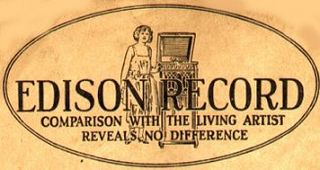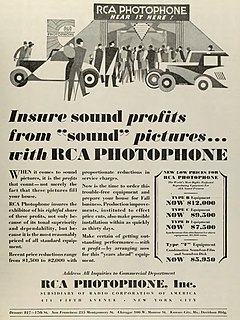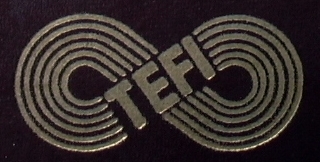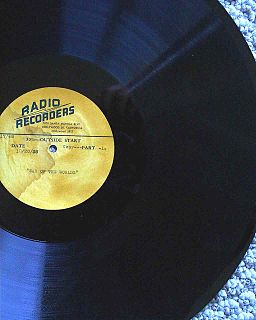
A phonograph, in its later forms also called a gramophone or since the 1940s called a record player, or more recently a turntable, is a device for the mechanical and analogue recording and reproduction of sound. The sound vibration waveforms are recorded as corresponding physical deviations of a spiral groove engraved, etched, incised, or impressed into the surface of a rotating cylinder or disc, called a "record". To recreate the sound, the surface is similarly rotated while a playback stylus traces the groove and is therefore vibrated by it, very faintly reproducing the recorded sound. In early acoustic phonographs, the stylus vibrated a diaphragm which produced sound waves which were coupled to the open air through a flaring horn, or directly to the listener's ears through stethoscope-type earphones.

A phonograph record, or simply a record, is an analog sound storage medium in the form of a flat disc with an inscribed, modulated spiral groove. The groove usually starts near the periphery and ends near the center of the disc. At first, the discs were commonly made from shellac, with earlier records having a fine abrasive filler mixed in. Starting in the 1940s polyvinyl chloride became common, hence the name "vinyl".

Mastering, a form of audio post production, is the process of preparing and transferring recorded audio from a source containing the final mix to a data storage device, the source from which all copies will be produced. In recent years digital masters have become usual, although analog masters—such as audio tapes—are still being used by the manufacturing industry, particularly by a few engineers who specialize in analog mastering.

The Edison Diamond Disc Record is a type of phonograph record marketed by Thomas A. Edison, Inc. on their Edison Record label from 1912 to 1929. They were named Diamond Discs because the matching Edison Disc Phonograph was fitted with a permanent conical diamond stylus for playing them. Diamond Discs were incompatible with lateral-groove disc record players, e.g. the Victor Victrola, the disposable steel needles of which would damage them while extracting hardly any sound. Uniquely, they are just under 1⁄4 in thick.

An acetate disc is a type of phonograph record generally used from the 1930s to the late 1950s for recording and broadcast purposes and still in limited use today.

Stereophonic sound or more commonly stereo, is a method of sound reproduction that recreates a multi-directional, 3-dimensional audible perspective. This is usually achieved by using two independent audio channels through a configuration of two loudspeakers in such a way as to create the impression of sound heard from various directions, as in natural hearing.

Sound recording and reproduction is the electrical, mechanical, electronic, or digital inscription and re-creation of sound waves, such as spoken voice, singing, instrumental music, or sound effects. The two main classes of sound recording technology are analog recording and digital recording.

RIAA equalization is a specification for the recording and playback of phonograph records, established by the Recording Industry Association of America (RIAA). The purposes of the equalization are to permit greater recording times, to improve sound quality, and to reduce the groove damage that would otherwise arise during playback.
The history of sound recording - which has progressed in waves, driven by the invention and commercial introduction of new technologies — can be roughly divided into four main periods:

RCA Photophone was the trade name given to one of four major competing technologies that emerged in the American film industry in the late 1920s for synchronizing electrically recorded audio to a motion picture image. RCA Photophone was an optical sound, "variable-area" film exposure system, in which the modulated area (width) corresponded to the waveform of the audio signal. The three other major technologies were the Warner Bros. Vitaphone sound-on-disc system, as well as two "variable-density" sound-on-film systems, Lee De Forest's Phonofilm, and Fox-Case's Movietone.

The LP is an analog sound storage medium, a phonograph record format characterized by: a speed of 33+1⁄3 rpm; a 12- or 10-inch diameter; use of the "microgroove" groove specification; and a vinyl composition disk. Introduced by Columbia in 1948, it was soon adopted as a new standard by the entire record industry. Apart from a few relatively minor refinements and the important later addition of stereophonic sound, it remained the standard format for record albums until its gradual replacement from the 1980s to the early 2000s, first by cassettes, then by compact discs, and finally by digital music distribution.
In the field of audio recording, an aluminum disc is a phonograph record made of bare aluminum, a medium introduced in the late 1920s for making one-off recordings. Although sometimes used for making amateur studio or home recordings or in coin-operated "record-your-voice" booths at fairs and arcades, during the first half of the 1930s bare aluminum discs were primarily used to record radio broadcasts for the private transcription disc archives of performers or sponsors.
Teldec is a German record label in Hamburg, Germany. Today the label is a property of Warner Music Group.

Direct metal mastering (DMM) is an analog audio disc mastering technique jointly developed by two German companies, Telefunken-Decca (Teldec) and Georg Neumann GmbH, toward the end of the 20th century after having seen the same technology used by RCA Princeton Labs for its SelectaVision videodiscs in the late-1970s.

The vertical cut recording process is an early method of audio recording by which a stylus cuts a vertical groove into a phonograph record. This is in contrast to the lateral recording system which uses a stylus that cuts side-to-side across a record. The vertical recording process, also known as the hill and dale process, was used to record phonograph cylinder records as well as Edison Disc Records, Pathé disc records, and disc records made by numerous smaller companies. Vertical cut recording was also used as a means of copyright protection by the early Muzak 16-inch background music discs.

The Tefifon is an audio playback format, developed and manufactured in Germany, that utilizes cartridges loaded with an endlessly looped reel of plastic tape. It is somewhat similar to the later 4-track and 8-track magnetic audio tape cartridges, but with grooves embossed on the tape, like a phonograph record. The grooves were embossed in a helical fashion across the width of the tape, in a manner similar to Dictaphone's Dictabelt format. The grooves are read with a stylus and amplified pickup in the player's transport. A Tefifon cartridge, known as a "Tefi", can hold up to four hours of music; therefore, most releases for the format are usually compilations of popular hits or dance music, operas and operettas. Tefifon players were not sold by television and radio dealers in Germany, but rather sold directly by special sales outlets affiliated with Tefi.

Electrical transcriptions are special phonograph recordings made exclusively for radio broadcasting, which were widely used during the "Golden Age of Radio". They provided material—from station-identification jingles and commercials to full-length programs—for use by local stations, which were affiliates of one of the radio networks.

Electric music technology refers to musical instruments and recording devices that use electrical circuits, which are often combined with mechanical technologies. Examples of electric musical instruments include the electro-mechanical electric piano, the electric guitar, the electro-mechanical Hammond organ and the electric bass. All of these electric instruments do not produce a sound that is audible by the performer or audience in a performance setting unless they are connected to instrument amplifiers and loudspeaker cabinets, which made them sound loud enough for performers and the audience to hear. Amplifiers and loudspeakers are separate from the instrument in the case of the electric guitar, electric bass and some electric organs and most electric pianos. Some electric organs and electric pianos include the amplifier and speaker cabinet within the main housing for the instrument.
IRENE is a digital imaging technology designed to recover analog audio stored on fragile or deteriorating phonograph cylinders, records, and other grooved audio media. It is in use by several archives and preservation institutions in the United States seeking to preserve and digitize historical audio.
Scully Recording Instruments was an American designer and manufacturer of professional audio equipment for recording studios and broadcasters.
















